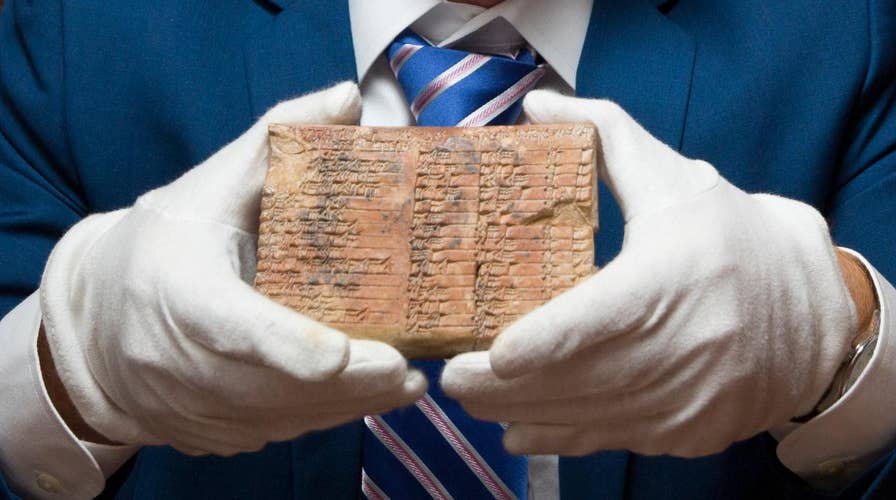Ancient Babylonian tablet mystery solved
New research into a 3700-year-old Babylonian tablet challenges what historians previously believed about mathematics
Scientists have revealed the secrets of a mysterious 3,700-year-old Babylonian clay tablet found by the archaeologist who inspired the fictional ‘Indiana Jones’.
Experts at the University of New South Wales Sydney in Australia have uncovered the purpose of the famous tablet, which they describe as the world’s oldest and most accurate trigonometric table. The artifact, they say, may have been used to by ancient scribes to help in the construction of palaces, temples and canals.
The tablet, known as Plimpton 322, was discovered in the early 1900s in what is now Southern Iraq by archaeologist, academic, diplomat and antiquities dealer Edgar Banks, who provided the inspiration for the fictional character ‘Indiana Jones.’
EXPERTS UNCOVER EVIDENCE OF ANCIENT JERUSALEM'S DESTRUCTION BY THE BABYLONIANS
“Plimpton 322 has puzzled mathematicians for more than 70 years, since it was realised it contains a special pattern of numbers called Pythagorean triples,” says Dr. Daniel Mansfield of the School of Mathematics and Statistics in the UNSW Faculty of Science, in a statement.

The tablet’s purpose has long baffled experts. It was not clear why the scribes had performed the complex task of generating and sorting the numbers on the tablet, according to Mansfield.
“Our research reveals that Plimpton 322 describes the shapes of right-angle triangles using a novel kind of trigonometry based on ratios, not angles and circles. It is a fascinating mathematical work that demonstrates undoubted genius,” he said. “The tablet not only contains the world’s oldest trigonometric table; it is also the only completely accurate trigonometric table, because of the very different Babylonian approach to arithmetic and geometry."
ANCIENT INSCRIPTION UNEARTHED IN JERUSALEM, THRILLING ARCHAEOLOGISTS
The tablet, which is thought to have come from the ancient Sumerian city of Larsa sometime between 1822 and 1762 B.C., is now in the Rare Book and Manuscript Library at Columbia University in New York.
A useful mathematical tool before the advent of calculators, trigonometric tables let you use one known ratio of the sides of a right-angle triangle to determine the other two unknown ratios.
The 15 rows on the tablet describe a sequence of 15 right-angle triangles, which are steadily decreasing in inclination, according to the UNSW. The left-hand edge of the tablet, however, is broken, although scientists built on previous research to present new mathematical evidence that there were originally six columns and the tablet was meant to be completed with 38 rows.
RARE 2,000-YEAR-OLD STONE WORKSHOP AND QUARRY DISCOVERED IN ISRAEL’S GALILEE
Researchers also demonstrated how ancient scribes, who used a base 60 numerical arithmetic similar to our time clock, rather than the modern base 10 number system, could have generated the numbers on the tablet.
The research provides an alternative theory to the widely-held view that the Plimpton 322 was a teacher’s aid for checking students’ solutions of quadratic problems. “Plimpton 322 was a powerful tool that could have been used for surveying fields or making architectural calculations to build palaces, temples or step pyramids,” said Mansfield, who first read about the tablet when preparing material for first-year math students.
UNSW scientists note that Plimpton 322 predates Greek astronomer Hipparchus, regarded as the father of trigonometry, by more than 1,000 years.
LOST ROMAN CITY THAT WAS HOME TO JESUS' APOSTLES FOUND, SAY ARCHAEOLOGISTS
“It is wonderful that Mr. Mansfield's work with Norman Wildberger is bringing more attention to this treasure of Columbia,” explained Jennifer Lee, a curator at Columbia University’s Rare Book and Manuscript Library, in a statement emailed to Fox News.
Plimpton 322 is one of 629 tablets written in ancient cuneiform script held by the Library. The tablet was bequeathed to Columbia by publisher George Arthur Plimpton, who had purchased the artifact from Edgar Banks.
ARCHAEOLOGISTS DISCOVER TOMBS FROM ANCIENT 'GREAT CEMETERY' IN EGYPT'S NILE VALLEY
Lee said that the idea of Plimpton 322 as a teaching tool is particularly apt, noting that Plimpton was a textbook publisher and he collected widely on the history of education.
Follow James Rogers on Twitter @jamesjrogers




















